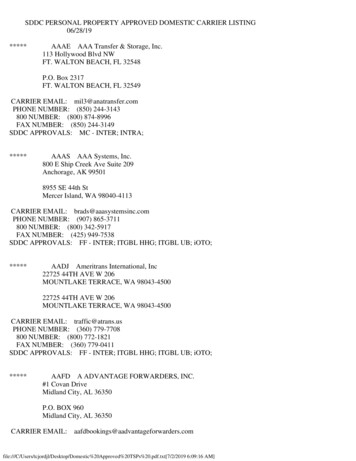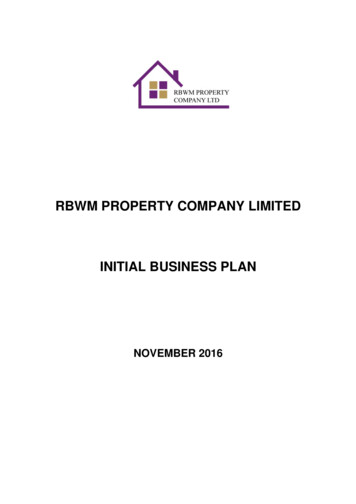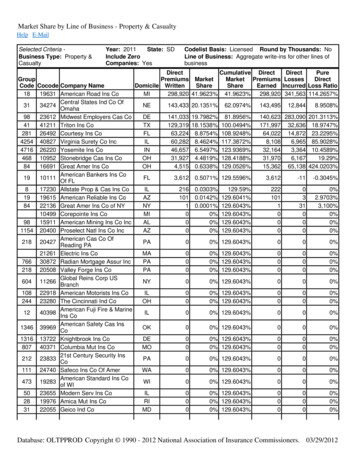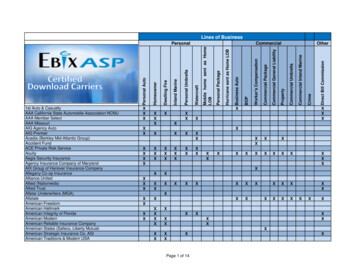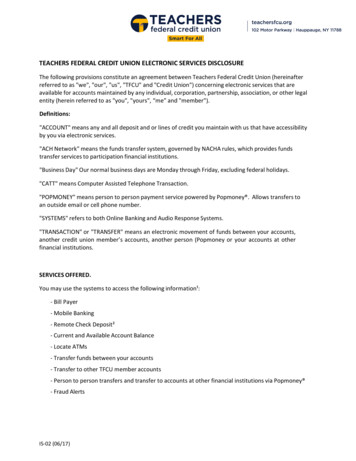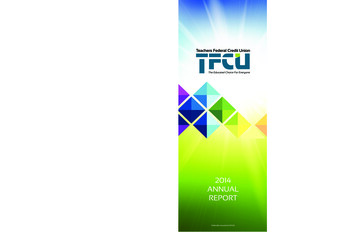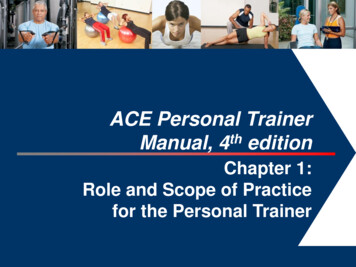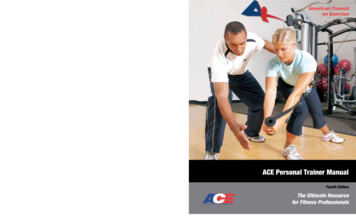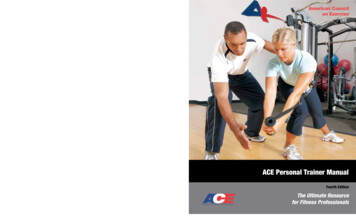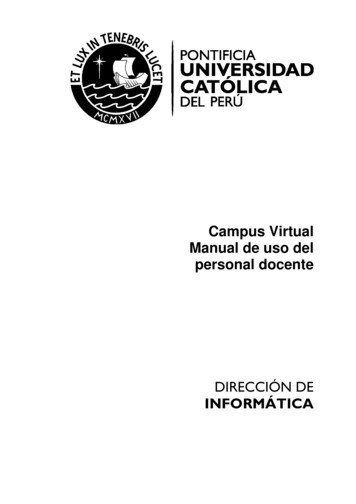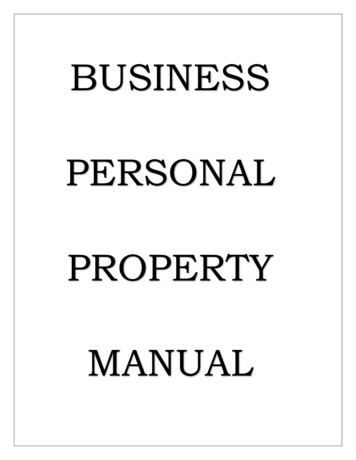
Transcription
BUSINESSPERSONALPROPERTYMANUAL
TABLE OF CONTINENTS Introduction to business personal propertyNew employees to business personal propertyBusiness personal property data clerk job tasksProcedures for greeting and assisting tax payersQuestions that you may be askedMail returned processProcedures for entering a new business into access databaseHow to mail merge from access for feelersBusiness personal property guide to finding new businessAppraiser assignmentsProcedures for inspecting new accuracy in the year they arecreatedProcedures for verifying the accuracy of work done by appraiserCall stepsProcedures for setting up new accountsProcedures on how to enter detailed segments into PACSSchool district and city codes in McLennan CountyItemized depreciation scheduleDepreciation tables for personal property & instructions on howto use themSic codesTaxing entities allowing goods in transit exemptionTaxing entities allowing Freeport exemptionProcedures for appraising non rendering accountsCappa grids for non-rendering accountsProcedures for deleting propertiesProcedures for incoming rendition handlingHow to save e-mailed renditionsProcedures for assessing or waiving penaltiesSupplement proceduresStaff procedures for informal meetings concerning protestDefense of values in appraisal review boardCapital appraisal group plan for reappraisalProcedures used to review work performed by Capital AppraisalGroup IncSteps for SIT (special inventory)Procedures for entering value
IntroductionThe Business Personal Property department of the McLennan CountyAppraisal District is responsible for developing fair and uniform market valuesfor businesses located in the district. The law requires that all property notspecifically exempt be taxed. However, because personal property is easilyconcealed and frequently moved because of the need to determine situs, thetaxation of personal property is more difficult than the taxation of realproperty.Items not permanently affixed to a real estate are generally considered to bepersonal property. To differentiate between real and personal property ourappraiser must consider the manner in which the property is attached orsecured in the location, the purpose for which it is used and whether it is toremain permanently affixed or be removed at some time. A general rule hereat MCAD is that an item is personal property if it can be removedwithout serious injury to the real estate or to the item itself.Discovery of PropertyThe extent to which taxable personal property can be assessed depends uponits discovery. Complete discovery requires adequate staff and supportingresources. It must be carried out with due respect to MCAD's standards,guidelines, statutory policies, and case law. Three major areas should beconsidered in a discovery program: method of discovery, interpretation ofdata, and situs.Since most personal property is movable in nature, the most difficult step inthe assessment of personal property is developing a system of property todiscovery.Listed below are several methods used in finding personalproperty.
1) The personal property rendition is a way for MCAD to setup newaccounts. This rendition allows us to apply its own depreciation schedulesto equipment, furniture and fixtures, computers and machinery that arelisted on the form.2) The use of newspapers, press releases, and trade magazines will oftenassist MCAD in locating the addition of personal property that results inthe new business opening or old businesses expanding within itsjurisdiction.3) Telephone and city directories are particularly valuable in locatingcommercial, service, or industrial operations new to the jurisdiction.4) Visual inspections (ride outs) are very helpful in finding new or closedbusinesses.5) Vehicle printout (VPO) secured by an outside vendor is the bestsource for vehicle information.6) The sales tax list provided by McLennan County is another greatresource. This list shows everyone who filed for a sales tax numberin the county.This is not an exhaustive list of all methods of discovering, but it is a list ofthe most common methods. The other appraisers in the residential andcommercial departments also look for new personal property as they dotheir field inspections and report any findings to the personal propertydepartmentProperty TaxableThere are different categories of personal property: inventory, supplies, fixedassets, leasehold improvements, and vehicles. Actual physical property thatcan be seen, weighed, measured, felt or otherwise perceived by the senses, butdoes not include a document or other perceptible object that constitutesevidence of a valuable interest, claim or right and has no intrinsic value isconsidered tangible personal property.
Examples of tangible personal property are: furniture and fixtures, machinery andequipment, machinery tools, dies, and inventory. This type of property is taxable inTexas if it is located in the state for longer than a temporary period or it iscontinually in the state. Personal property that is not tangible or properties thathave evidence of ownership of property rights and may be in the form of adocument are intangible personal property. Examples of intangible personalproperty are: raw materials, work in progress, finished goods, and goods held forresale.It is MCAD's duty to place all taxable personal property on the roll. If the ownerfails to render the property it is our constitutional duty to assess the property.InventoryAll items of personal property that are to be bought and sold for the principlepurpose of making a profit are called merchandise and make up the merchants ormanufacturers stock or inventory. Items that are used in connection with theoperation of a business or profession, but are not for sale, are called supplies.Merchant inventory can include stock in trade, consigned goods, and goods instorage. Stock in trade consists of commodities comprising both goods andequipment, if these are held for resale. Most stock in trade in the hands ofretailers and wholesalers belongs to the merchant who holds them. Inventory maysometimes contain consigned goods which would be noticed to the consignor.Goods Held for ResaleThis type of inventory is usually merchandise in the hands of a retailer, wholesaler,distributor, or public warehouse, and may have already passed through the variouschannels of trade. An appraisal of goods held for resale must carry the full cost atthe level of trade where the goods are currently resting.
Consigned GoodsConsigned goods are inventories in the possession of an agent, usually held forsale by that agent. Ownership of the inventory is retained by the consignor. Theagent, as the consignee, simply sells the goods for a fee or a commission.Goods in StorageIn most cases, goods in storage are taxable by the jurisdiction in which they arelocated. The chief exceptions are when the goods are in transit ininterstate commerce and meet the statutory requirements.Raw MaterialsRaw materials are natural resources used in manufacturing and manufacturedgoods awaiting assemblage into a new product. This type of inventory is usuallyin the hands of the manufacturer.Goods in ProcessGoods in process have been placed into a manufacturing process, which hasbegun to change their form. Direct and indirect labor costs and otherexpenses have accrued to these goods in the process.Finished GoodsThis property has become a finished product to be shipped to a buyer or profitcenter of the manufacturer and ultimately sold.In Transit GoodsGoods in the hands of a common carrier or other carrier are deemed to be intransit. Usually these goods are moving from one point to another. In mostsituations, the goods cannot be assessed if they have not reached theirdestination.
Leased EquipmentLeased items differ from otherwise similar personality because they produceincome for the owner not through use but through receipt of rents in exchangefor the use by someone else. Assessors are discovering the taxpayers today leaseeverything from credit card machines to earth moving equipment. Difficultiesarise in all aspects of assessment: finding and listing the property, determiningthe property owner, determining the appropriate trade level at which theproperty is to be valued at, valuing the property, establishing situs and taxliability, avoiding duplicate assessments, and handling special problems withexternal and functional obsolescence.Leasehold ImprovementsLeasehold improvements can include almost any type of tangible personalproperty but are here considered separate due to the special situs and taxliability issues involved. Whether improvements made by a leaseholder areassessed as real or personal property will depend on the statutory mandatesand office policies and procedures, all of which vary greatly from state to state.The appraiser may need to review a detailed list to identify those itemspermanently attached to the building. The taxpayer's total investment in aleasehold improvement account must be appraised, whether as real or personal;at the same time, duplicate assessment must be avoided.Watercraft and AircraftWhen it comes to aircraft and watercraft, MCAD uses listings from outsidesources. These listings come from Texas Parks and Wildlife, FAA, andairport hangar listings.VehiclesWhen it comes to appraising vehicles, MCAD uses an outside vendor. Thisvendor provides us a listing of all commercial and business vehicles registered inthe county. This vendor also provides us values of the vehicles using the NADABlue Book. Vehicles reported to us on renditions are valued in house using theNADA and Kelley Blue Book
Assessment dateBy law, property which is taxable on January 1 remains taxable for the entireyear no matter what occurs later in the year. For example, if a business closes inMarch, the owner is still responsible for the taxes for that yearMechanics of Assessment Place of TaxationSitus is the place where property is taxable. Personal Property is taxable if it is inthe jurisdiction on January 1st for more than a temporary period. A taxingjurisdiction can only assess personal property that has a situs within itsboundaries. Property usually has situs at its normal location or home base. RenditionsRenditions filed with MCAD are confidential and are not open to the public forinspection. Below is the MCAD "Guide to Business Personal Property Rendition ofTaxable Property" worksheet available to the taxpayers.Texas Property Tax Laws require taxpayers to render all tangible property, usedor held for the production of income as of January 1st. To render means, to listall property used or held for the production of income. Property owners mayprotest appraised values before the appraisal review board (Texas Property TaxCode, Section 25.19).Although the state mandated deadline to file a business personal propertyrendition is April 15th, MCAD encourages early submission by March 2nd if at allpossible.There is also an automatic 30 day extension available for business owners if theyapply for it by April 15th. (The only requirement is that it must be in writing.)Renditions are confidentialInformation contained in a rendition cannot be disclosed to third parties except in verylimited circumstances. In addition, the tax code specifically provides that any "goodfaith estimate" of value provided is not admissible in proceedings other than a protestto the ARB or court proceedings related to the penalties for failure to render. The finalvalue placed on any property is public information, but the rendition is not.
The rendition must be filed by April 15th by one of the following methods: The mailing address for the general rendition form is:McLennan County Appraisal DistrictPO Box 2297Waco, TX 76703-2297 The street address for onsite or physical deliveries to MCAD is:315 S 26th St.Waco, TX 76710-7400 The e-mail address for electronic filing on rendition information is:pp@mclennancad.orgPenalties for failure to file the rendition or the explanatory statement:There are two levels of penalty for failure to comply. If you fail to file therendition before the deadline or one is not filed at all, the penalty is equal to10% of the amount of taxes ultimately imposed on the property. This isaccording to section 22.28 of the Property Tax Code. To appeal late penalties forrenditions that were mailed but not received by MCAD, you must havedocumented proof from a mailing service. If a court determines that a taxpayerhas committed fraud or committed other acts with the intent of evading taxeson the property, a penalty equal to 50% of the taxes ultimately Imposed on theproperty may be levied.
Taxpayer Rights for PenaltiesIf a penalty is assessed against you, you can file a request for a waiver of thepenalty. You must file the request in writing with the chief appraiser within 30days after you receive the notice that the penalty has been imposed. Yourrequest must include documentation showing that either you substantiallycomplied with the rendition law or that you made a good faith effort to do so.The documentation should also address:1) Your compliance history with respect to paying taxes and filing statements orreports;2) The type, nature, and taxability of the specific property involved;3) The type, nature, size, and sophistication of your business;4) The completeness of your records;5) Your reliance on advice provided by the appraisal district that may havecontributed to your failure to comply and the imposition of the penalty;6) Any change in appraisal district policy during the current or preceding tax yearthat may affect how property is rendered; and7) Any other factors that may have caused you to fail to timely file a statement orreport.The chief appraiser is required by law to consider these factors and notify you inwriting of his determination. If the chief appraiser declines to waiver a penaltyand you have made a timely request for waiver, you may protest the impositionof the penalty to the appraisal review board. The board may waiver the penaltyif it finds that you substantially complied with the rendition law or made a goodfaith effort to do so.Exemptions Vehicle exemption from ad valorem taxation for one motor vehicle (passengercar or light duty truck with a manufacturer's rated carrying capacity of one tonor less) owned by an individual that is used in the course of the owner'soccupation and also for personal activities of the owner. The exemption doesnot apply to a vehicle (taxi, limousine, etc.) used to transport passengers forhire. This exemption must be applied for annually no later than April 30th of thetax year.
Goods-in-transit exemption from ad valorem taxation of tangible personalproperty (inventory) that is detained at a location in this state that is not owned,either directly or indirectly, or under the control of the person who acquired orimported the tangible personal property, and the tangible personal property istransported to another location in or out of this state within 175 days. This is acomplex law similar to the exemption of Freeport goods and is only available inthose taxing units that have not elected to tax goods-in-transit. This exemptionmust be applied for annually no later than April 30th of the tax year. Freeport exemption from ad valorem taxation of tangible personal property(inventory) that is acquired in or imported into this state to be forwardedoutside this state. The property must be transported outside of this state notlater than 175 days after the date the person acquired or imported the propertyin this state. The exemption is only available in those taxing units that have notelected to tax Freeport goods. The exemption must be applied for annually nolater than April 30th of the tax year. Pollution control exemption from ad valorem taxation of personal property thata person owns and that is used wholly or partly as a facility, device, or methodfor the control of air, water, or land pollution. This exemption must be appliedfor annually no later than April 30th of the tax year.
NEW EMPLOYEES TO BUSINESS PERSONAL PROPERTYWelcome to business personal property by Senior Appraiser (BPP Supervisor) Introduced to the BPP staff appraisers and data clerk. Overview of the office and layout Sit down with Supervisor and go over duties and functions of the BPPDepartment and individual responsibilities Given Course 1 book "Intro to the Texas Property Tax System-to read through toget a feel for the functions of the appraisal district, and then Course 4 "PersonalProperty Appraisals" for the same reasonThe new staff member then works with an appraiser or data clerk to observe.
Business Personal Property Data Clerk Job Tasks1. Greet & assist taxpayers with rendition forms, address changes,copies of previously filed renditions, and misc. questions.(Procedures for Greeting & Assisting Taxpayers)2. Answer telephones. (SMILE — Personal Property, this is , howmay I help you?)3. Gather information of new businesses property owners and closingof businesses. (Procedures for Setting Up New Accounts)4. Setup properties. (Procedures for Setting Up New Account In PACS)5. Delete properties. (Procedures for Deleting Properties)6. Research and add new assumed names to access list database.(Procedures for Entering New Businesses into Access Database)7. Research and add new businesses from the phone book into access listdatabase. (Procedures for Entering New Businesses into AccessDatabase)8. Assist appraisers with preparing of Appraisal Review BoardHearings. (As instructed by appraisers)9. Set appointments for appraisers with business owners.10. Enter detailed segments and sub segments in PACS. (Procedures for Entering Infoin PACS for Segment Details on Renditions)11.Filing of deleted properties and active accounts. (Files are to be filedin the order PACS has them sorted)12. Enter, setup and maintain SIT accounts. (Procedures for EnteringValues for the SIT Accts)
13.Verify data entry on appraisal sub segments for correction to taxroll. (As instructed by appraisers)14.Create and maintain documents in Excel or Word for yearlyrendition extensions, tenant lists for various businesses, and list ofbusinesses needing explanatory letters for more info needed.15. Mailing address corrections for our office, tax office and lawyer’soffice. (Mail Return Process)16. Scanning documents as needed. (Procedures for Incoming RenditionHandling)
Procedures for Greeting & Assisting Taxpayers1. When greeting taxpayers, whether you are on the phone or in person,ALWAYS SMILE!!! You can hear it in your voice if you're smiling.2. When assisting with rendition forms, the taxpayer is REQUIRED to do thewriting on the forms unless you have received prior authorization fromthe supervisor to do the writing for them. Always ask for an alternativemailing address other than the business location in case we have mailreturned. Always ask for a phone number in case we need to contactthem via telephone. When filling out renditions, make sure the taxpayersrealizes that if they can give us a year acquired, a description of theasset, and the actual cost, their tax will reduce each year until it reaches20% of what they paid for it. This goes for everything but computers,they will reduce to a 10% residual. This property has "value in use" eventhough it may be fully depreciated on the company's books for IRStaxation. It still does the same job that it was originally attained toperform and creates income for the business. If they do not know orrefuse to give you this in-depth information, they can give you a goodfaith estimate, but be sure to tell them it will be given a flat value andwill NOT reduce in value by doing so. Give them a copy of the renditionfilled out so next year they will know what information they gave us. Itwill make it easier for them and our office if they just want to makeanother copy of the same informati
Inventory All items of personal property that are to be bought and sold for the principle purpose of making a profit are called merchandise and make up the merchants or manufacturers stock or inventory. Items that are used in connection with the operation of a business

